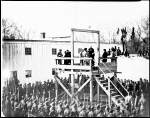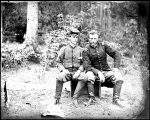Today in History: November 10
Andersonville Prison

Reading the Death Warrant to Wirz,
Washington, D.C.,
November 10, 1865.
Civil War Photographs, 1861-1865
Henry Wirz, former commander of the infamous Confederate prison at Andersonville, Georgia, was hanged on November 10, 1865 in Washington, D.C. Swiss-born Wirz was assigned to the command at Andersonville on March 27, 1864. When arrested on May 7, 1865, he was the only remaining member of the Confederate staff at the prison. Brigadier General John Winder, commander of Confederate prisons east of the Mississippi and Wirz's superior at Andersonville, died of a heart attack the previous February.
A military tribunal tried Wirz on charges of conspiring with Jefferson Davis to "injure the health and destroy the lives of soldiers in the military service of the United States." Several individual acts of cruelty to Union prisoners were also alleged. Caught in the unfortunate position of answering for all of the misery that was Andersonville, he stood little chance of a fair trial. After two months of testimony rife with inconsistencies, Wirz was convicted on all counts and sentenced to death.
On the morning of November 10, 1865 Henry Wirz
rose in his cell at the Old Capitol and wrote a last letter to his wife…Later that afternoon, after giving a few final strokes to a stray cat that had wandered in to share his confinement, he emerged from his cell with a black cambric robe draped over his shoulders…He followed the guards into an enclosed courtyard, where chanting soldiers and other spectators hung like vultures in the street. There was his life offered up to appease the public hysteria.William Marvel, Andersonville: The Last Depot
(Chapel Hill, N.C.: University of North Carolina Press, 1994), p. 246-247.

Lt. James B. Washington, a Confederate Prisoner, with Capt. George A. Custer
of the 5th Cavalry, U.S.A.,
Fair Oaks, Virginia, May 31, 1862.
Civil War Photographs, 1861-1865
Collapse of the prisoner exchange system in the summer of 1863 contributed significantly to deplorable conditions at Andersonville. Until 1863, the Union and Confederate armies regularly traded prisoners of war, keeping the number of incarcerated soldiers to a minimum. These exchanges were ended because the Confederacy refused to exchange African-American prisoners. After the cessation of prisoner exchanges, the number of Union prisoners in Richmond swelled to unmanageable size.
In November 1863, Confederate officials selected Andersonville as the site of a new prison. Prisoners began arriving at the hastily constructed and completely inadequate facility in February 1864. Forced to provide their own shelter, scrounge for edible food, and contend with a contaminated water supply, they were decimated by starvation and infectious disease. More than 13,000 of the 49,485 soldiers sent to Andersonville in 1864 and 1865 died there.

Letter with Colored Sketch, James W. Duke to Unidentified Cousin,
Written from a Union Prison Camp, August 31, 1864
Words and Deeds in American History
Approximately 150 military prisons were created by Confederate and Union armies during the Civil War. On August 31, 1864, Confederate prisoner of war James W. Duke wrote a letter from the federal prison at Rock Island, Illinois to a cousin in Kentucky. The letter includes an account, probably censored, of conditions at the prison and a drawing of the facility.
During the late winter of 1862, 800 Confederate prisoners were temporarily incarcerated in Lafayette, Indiana. Writing about this "Forgotten Chapter in Lafayette's Civil War," WPA writer Cecil Miller noted, "Most of the prisoners were young men, pale, beardless boys, some under seventeen, members of the 32nd and 41st Tennessee regiments. They had served but four and one-half months." Although prison life was grim on both sides, the misery of war occasionally was lightened by a game of baseball as shown in Otto Boetticher's 1863 lithograph Union Prisoners at Salisbury, N.C..
Learn more about the Civil War:
- Visit the National Park Service site Archeology at Andersonville to learn more about life at Andersonville Prison. Now designated Andersonville National Historic Site, the former prison serves as a memorial to all American prisoners of war.
- Find additional American Memory material on the war. Search on Civil War in the following collections:
- African American Perspectives, 1818-1907
- American Life Histories, 1936-1940
- California As I Saw It: First Person Narratives, 1849-1900
- California Gold: Folk Music from the Thirties, 1938-1940
- Taking the Long View, 1851-1991
- Votes for Women, 1848-1921
- Words and Deeds in American History
- Pioneering the Upper Midwest, 1820-1910
- Browse the collection Civil War Photographs, 1861-1865 to view images from the period. Search the collection on Wirz to view more photographs of the execution.
- Search the Today in History Archive on Civil War to locate features highlighting:
- General Lee's evacuation of Richmond;
- Military engagements at Bull Run, Vicksburg, and Antietam;
- Key figures and events of the era including Jefferson Davis, Stonewall Jackson and Abraham Lincoln's Gettysburg Address.